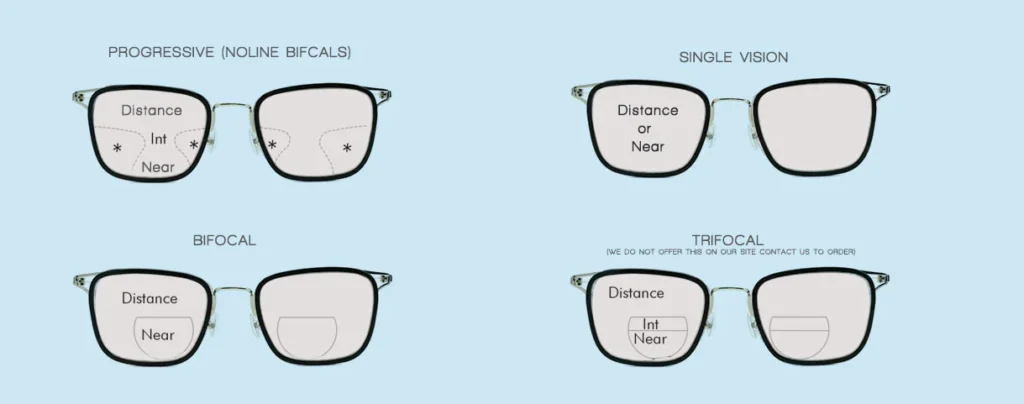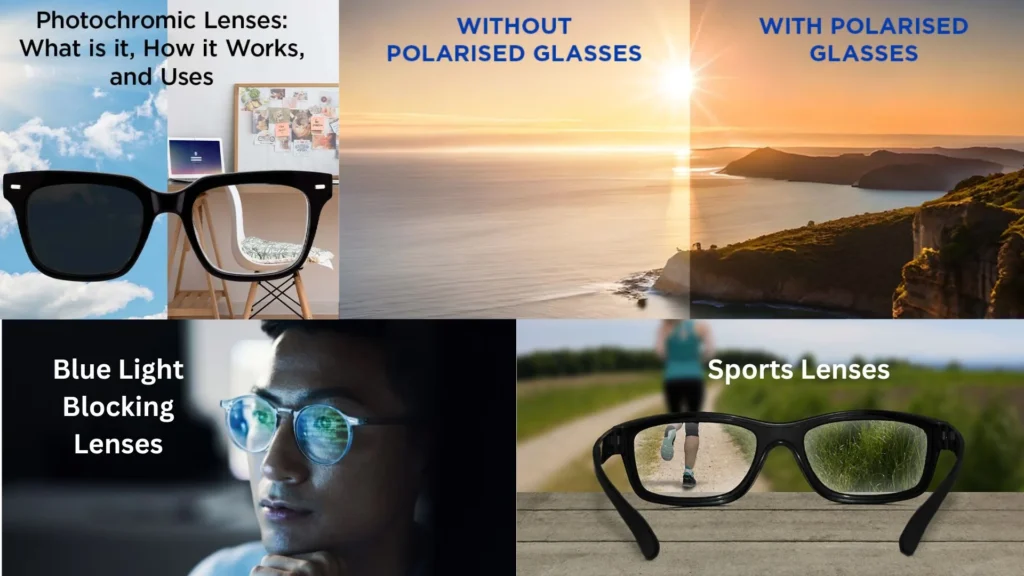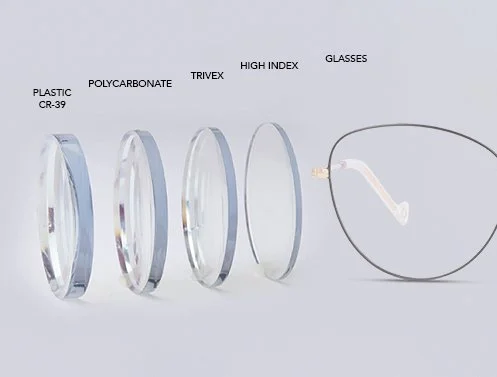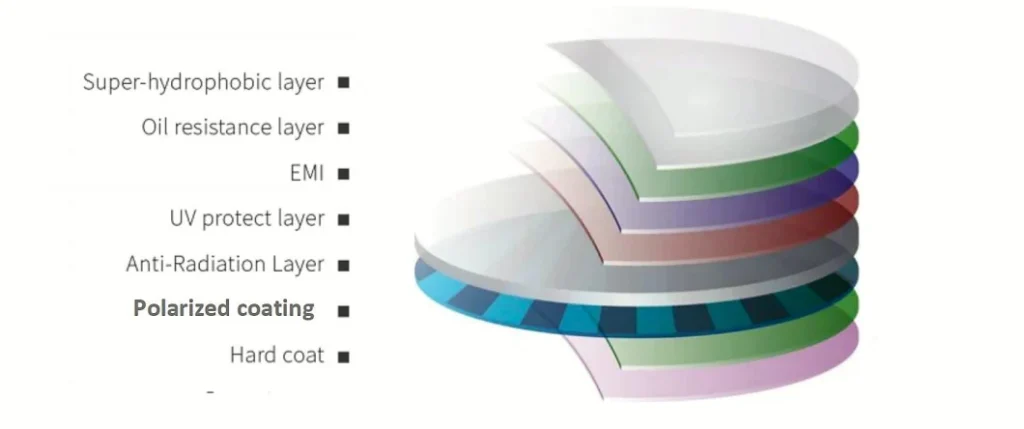Types of eye lenses for glasses: Eyeglasses are more than just a tool to improve your vision; they play a lot of daily lives and comfort. Whether you are reading, driving, or working at a computer, the quality of lens type can significantly enhance your visual experience. This comprehensive guide will help navigate the world of eyeglass lenses and coatings to find the best option for your vision needs and lifestyle.
Overview of Eyeglass Lenses and Why the Right Choice Matters
The correct eyeglass lens will make the difference in your life to correct and feel comfortable. Various types of lenses, materials, and coatings are available; it is helpful to know exactly what you need. The period taken to get accustomed to the new glasses varies; however, when you get the best lens for your vision, then the process will be as easy as it can get. Let us proceed and delve into various types of lenses and their coatings, and how that can assist in making an informed choice.
Types of eye lenses for glasses
Single Vision Lenses: Description and Best Use Cases
Single vision lenses are corrective lenses that provide correction at a single distance, either near, intermediate, or far. These are the most frequently used as they cater to individuals who have myopia, hyperopia, or astigmatism conditions. Single vision lenses therefore represent the average solution in simple vision requirements, with clarity and convenience for reading, driving, or general use.
Bifocal Lenses: Explanation of Dual Prescriptions in One Lens

Bifocals are lenses that correct near and distance vision, divided into two distinct sections: the upper portion has a prescription for distance vision, and the lower portion deals with near tasks, like reading. Often, a visible line separates these two prescriptions, which makes this option highly desirable for patients with presbyopia – the impairment of near focusing ability, usually starting in mid-life.
Trifocal Lenses: Ideal for Near, Intermediate, and Far Vision Needs
The next stage is trifocal lenses, which bring bifocal functionality one step higher by having a third segment for intermediate vision, something important for computers or reading at arm’s length. Trifocals are great lenses for people who need to see clearly at multiple distances and are better suited for more complex prescriptions. Because the lens is divided into three areas, all ranges are covered.
Progressive Lenses: Seamless Vision at All Distances Without Visible Lines
Progressive lenses, also known as no-line bifocals, give a seamless transition between near, intermediate, and distance vision without the visible lines seen in bifocals and trifocals. Those who prefer more seamless and aesthetically pleasing options tend to prefer these lenses. Progressives have a gradual change in prescription across the lens, so they are best suited for individuals who need multifocal vision correction but want to avoid the stark contrast of traditional bifocals.
Prism Lenses: Correction for Eye Alignment Issues
Prism lenses are designed to correct binocular vision problems, including double vision (diplopia) or misalignment of the eyes (strabismus). These lenses correct the visual field by bending light in a way that ensures the eyes work together properly, creating a single, clear image. Prism lenses are especially useful for those who experience eye strain or headaches due to misalignment.
Specialty Vision Types of eye lenses for glasses
Reading Glasses: Advantages for Near-Sightedness
Reading glasses are prescription eyewear to correct presbyopia and make reading or working with a smartphone easy. Almost all reading glasses can be purchased over the counter, but a prescription for reading glasses would ensure an exact fit and result in better clarity and comfort. Reading glasses are really good for those who need corrective lenses only for seeing near objects.
Sun Bifocals and Progressives: Best Uses for Outdoors
Sun bifocals and progressives are multifocal lenses that carry the extra protection of sunglasses. This kind of lenses is ideal for outdoor performances where vision correction and sun protection must be had together. With the capability to transition between different focal points, sun bifocals and progressives bring comfort and convenience under bright conditions.
Anti-Fatigue Lenses: Relief for Digital Eye Strain
Anti-fatigue lenses are designed to ease the strain on your eyes from prolonged use of digital screens. These lenses help alleviate the discomfort associated with looking at screens for long hours by providing subtle power alterations that reduce eye strain. They are especially useful to those who spend considerable hours in front of computers or other digital devices.
Types of Specialty eye lenses for glasses
Photochromic Lenses (Transition Lenses): Darken in Sunlight, Adaptable for Indoor and Outdoor Use
Photochromic lenses are also referred to as transition lenses since they change their tint automatically through reaction to UV lights. They become darker in sunlight and clear up indoors. Such a property is very helpful to those who frequently change lighting environments. The lenses, therefore, provide protection from harmful ultraviolet rays without the inconvenience of switching between glasses.
Polarized Lenses: Glare Reduction for Outdoor and Driving Use

Polarized lenses remove glare caused by reflective surfaces such as water, snow, or roads and are created for just this purpose of glare reduction. Because polarized lenses block horizontally reflected light, they are ideal to increase visual clarity and decrease eye strain for any outdoor activity which includes fishing, skiing, or driving. Polarized lenses should be a requirement for people who spend many hours outdoors or in bright surroundings.
Blue Light Blocking Lenses: Protection Against Digital Eye Strain
Blue light blocking lenses are the new answer to protection against damaging effects caused by blue light emitted from digital devices. Now, with digital devices becoming commonplace, this case has developed as a means to ensure your eyes are safe and sound from digital eye strain, disrupting sleep patterns, and even chronic eye conditions over time. Blue light blocking lenses filter out an acceptable percentage of this light and ease relief from staring at screens for hours.
Sports Lenses: Durable Lenses for Active Lifestyles
Sports lenses are made to be durable and resistant to abrasion, which is ideal for active people who actively play sports like running, cycling, or walking in daily life. In fact, such lenses can be made out of polycarbonate, which is lighter and less shatter-prone compared with other lenses. Such high-impact lenses can sustain the rough and tumble wear and tear of sports. Sports lenses may also possess UV blocking and anti-scratch coatings that make them perfect for sports activities.
Safety Lenses: High-Impact Lenses for Workplace Protection
Safety lenses are developed to meet the high-impact protection requirements of hazardous workplaces. They are usually made from polycarbonate or other strong materials that can protect against debris, chemicals, and other workplace hazards. Safety lenses can also be equipped with coatings that enhance durability and optical clarity.
Types of Lens Materials
Glass Lenses: Pros and Cons of Optical Clarity and Durability
Glass lenses are the traditional choice for eyeglasses because they offer better optical clarity with scratch resistance. However, the modern glass lenses weigh more and break easily compared with other modern options. Though they are perfect in terms of visual quality, the weight and fragility of glass present a reason why fewer people opt for them today.
Plastic Lenses: Lightweight, Affordable, and Versatile

Plastic lenses, in particular the CR-39 type, are relatively lighter and less expensive than glass. These are hardy and easily tinted, with several coating alternatives, making them versatile for most eyeglass wearers. Overall, plastic lenses have a balance between cost, comfort, and optical clarity, making them perfect for daily use.
Polycarbonate Lenses: Shatter-Resistant Option for Safety
Polycarbonate lenses are impact resistant, thus having a point of edge in any safety glass or sports wear. Polycarbonate lenses are also lighter in weight and thinner compared to usual plastic lenses, which can be very comfortable for long term wear. Being shatter-resistant polycarbonate lenses make the lens suitable for kids or an active lifestyle
High-Index Lenses: Thinner Lenses for Stronger Prescriptions
The lenses are thinner and lighter as compared to the standard plastic lens. It is an ideal choice for people with a strong prescription. The same vision correction can be provided without the thickness and weight of traditional lenses by using higher index of refraction materials, and it offers a more cosmetically appealing option.
Aspheric Lenses: Flatter Design to Reduce Lens Bulge for Higher Prescriptions
These lenses are aspheric in design to have a flatter curvature that often removes the bulging that seems to occur with most higher prescription lenses. Design also improves its aesthetics with better optical quality, providing a slimmer profile without sacrificing clear vision. Aspheric lenses tend to be of more value to those consumers with higher prescriptions and seeking a more streamlined look.
Key Material Attributes
Index of Refraction: How Lens Material Affects Thickness and Weight
The index of refraction is the degree to which a lens material can bend light. High-index materials bend light more efficiently, so lenses can be thinner for very strong prescriptions. The higher the index, the thinner and lighter the lens will be, making high-index lenses popular for comfort and aesthetics.
Abbe Value: Importance in Visual Clarity and Color Accuracy
Abbe value: a measure of how much chromatic aberration, or color distortion, a lens material induces. The better the lens material, the higher is the Abbe value it possesses. The more accurately you require to view the object, the more critical it is to choose material with a high Abbe value. Which of the lens materials will allow you to see clearly, distortion-free can be known through an Abbe value.
Types of Lens Coatings and Treatments
Anti-Reflective (AR) Coating: Reduces Glare and Reflections
Anti-reflective coating reduces glare from computer screens, headlight glare, and lighting in a room. It enhances vision by eliminating unwanted reflections across the lenses, thus appearing invisible. Coatings by AR are great for people who spend most of their time working under bright lights or using digital devices.
UV Protection: Shields Your Eyes from Harmful Ultraviolet Rays

Prevention of eye damage is highly necessitated due to the existence of harmful ultraviolet rays, which will adversely cause cataracts and other eye conditions. Many sophisticated lenses have UV protection already, but ensure that your lenses have a full 100% coverage of UVA and UVB. This coating is very important for those people who live in outdoor settings.
Scratch-Resistant Coating: Extends the Life of Your Lenses
Scratch-resistant coating helps save lenses from daily wear, thus increasing their lifespan by maintaining optical clarity. However, no lens is really scratch-proof, but this added an extra layer of the durability that makes it perfect for people who want them to last longer, especially in active environments.
Anti-Fog Coating: Reduces Lens Fogging in Different Environments
Anti-fog coating ensures glasses are not a problem in moist or cold conditions, allowing one to have a clear view at any temperature shift. This anti-fog coating is most useful for those who frequently change climate or are those persons who do activities where lenses easily fog over due to moisture, such as cooking and exercising.
Hydrophobic and Oleophobic Coatings: Repels Water, Dust, and Fingerprints
The hydrophobic and oleophobic coatings will repel water, dust, and oils, making cleaning easier and the lens clearer throughout the day. This is suitable for people who will usually find themselves wiping their lenses or for people living in a wet, dusty environment.
Conclusion
In conclusion, selecting the right types of eye lenses for glasses is essential for optimizing your vision and comfort in various situations. There are many types of eye lenses for glasses available, each designed to cater to specific needs, such as single vision for everyday use or progressive lenses for seamless multifocal correction.
By understanding the different types of eye lenses for glasses, you can choose the one that best matches your lifestyle and visual demands. Moreover, coatings like anti-reflective, UV protection, and scratch-resistant treatments can enhance the performance of these types of eye lenses for glasses. For outdoor enthusiasts or digital screen users, the appropriate types of eye lenses for glasses offer protection and durability.
Consulting with your eye care professional ensures that you receive the best-suited types of eye lenses for glasses for your prescription. The variety of types of eye lenses for glasses available today allows for tailored solutions, whether you’re addressing specific vision issues or seeking added comfort. Ultimately, the right types of eye lenses for glasses can significantly improve your visual experience and help protect your eyes for the long term.







